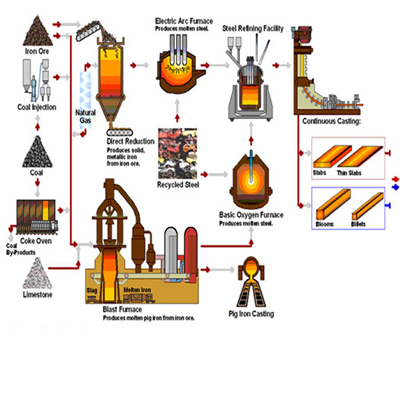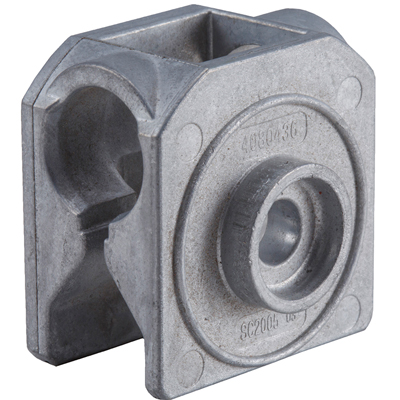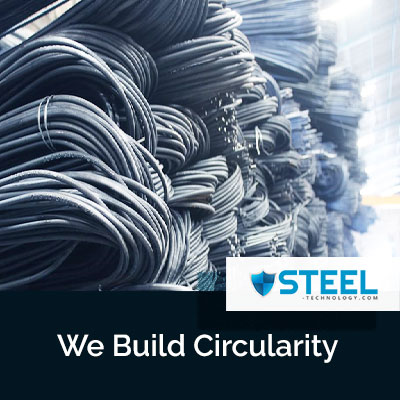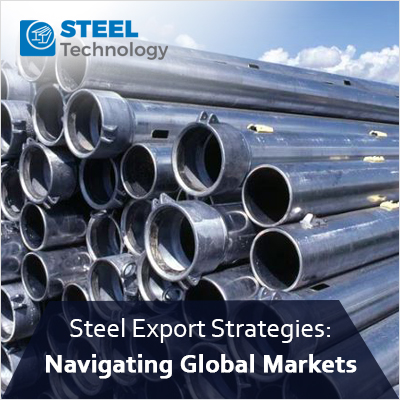Stainless Steel Overview: Types, Buying Guide, and Global Suppliers
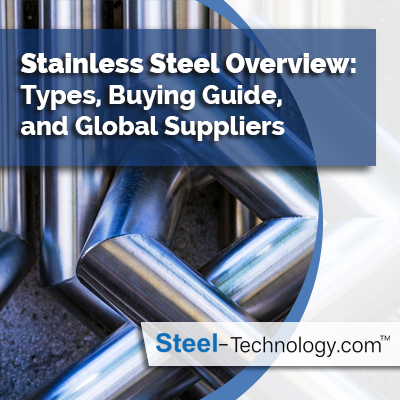
Overview
Stainless steel (Also known as Inox Steel) is an alloy of Iron with a minimum of 10.5% Chromium.
Chromium is used as it produces a thin layer of oxide on the surface of the steel known as the 'passive layer'. It helps to prevent any further corrosion of the surface. Increased resistance to corrosion can be attained by increasing the amount of Chromium.
The excellent resistance to stain or rust is due to its chromium content, usually from 12 to 20 percent of the alloy. Stainless stain also contains various amounts of Carbon, Silicon and Manganese. Other elements such as Nickel and Molybdenum may be added to impart other useful properties such as enhanced formability and increased corrosion resistance.
Therefore, there are numerous grades of stainless steel with varying chromium and molybdenum contents to suit the environment.
Stainless steels' resistance to corrosion and staining, low maintenance make it an ideal material for many applications where both the strength of steel and corrosion resistance are required.
Raw Materials
Stainless steels are made of some of the basic elements: iron ore, chromium, silicon, nickel, carbon, nitrogen, and manganese. Properties of the final alloy are tailored by varying the amounts of these elements.
For example, including Nitrogen in the alloy helps to improve tensile properties like ductility and corrosion resistance, which makes it helpful for use in duplex stainless steels.
| Also Read: The Evolution of Stainless Steel: New Grades and Applications |
Types of Stainless Steel
The main categories of stainless steels are:
a) Austenitic (200 and 300 series) Stainless Steels
b) Ferritic (400 Series) Stainless Steels
c) Martensitic (400 and 500 series) Stainless Steels
d) Precipitation-hardening (PH) Stainless Steels
e) Duplex Alloys/stainless steel
a) Austenitic (200 and 300 series) Stainless Steels
Austenitic stainless steels are the most common stainless steels containing at least 16% chromium making it suitable for the best corrosion resistance. They contain an austenitic microstructure, which is a face-centered cubic crystal structure. Their microstructure is derived from the addition of Nickel, Manganese and Nitrogen. They cannot be hardened by heat treatment since they possess the same microstructure at all temperatures. Moreover, their austenitic microstructure gives them excellent formability and Weldability.
Austenitic stainless steels can be further subdivided into two sub-groups, 200 series and 300 series:
200 Series are chromium-manganese-nickel alloys which maximize the use of manganese and nitrogen to minimize the use of nickel. 200 series posses 50% higher yield strength than 300 series stainless steel due to the addition of nitrogen.
For example: Type 201 is hardenable through cold working; type 202 is a general purpose stainless steel.
Corrosion resistance will be decreased when nickel content is reduced and manganese content is increased.
300 Series are chromium-nickel alloys, and they attain microstructure exclusively by nickel alloying. This series is the most widely used series and is the largest group.
The best known grade is Type 304, also known as 18/8 and 18/10 for its composition of 18% chromium and 8%/10% nickel, respectively. The second most common austenitic stainless steel is Type 316. The addition of 2% molybdenum provides greater resistance to acids and to localized corrosion caused by chloride ions.
b) Ferritic (400 Series) Stainless Steels
Ferritic (400 Series) Stainless Steels have 10.5 to 27% chromium and no considerable nickel content, reducing their corrosion resistance. They are considered best for high-temperature instead of high-strength applications.
They are preferred for their resistance to stress corrosion cracking. Ferritic stainless steels are magnetic and their grades include 430 and 434.
c) Martensitic (400 and 500 series) Stainless Steels
Martensitic (400 and 500 series) Stainless Steels have the highest hardness. These are magnetic and can be hardened by a combination of cold work and heat treatment.
The martensitic alloys contain 12 to 14% chromium, 0.2 to 1% molybdenum, and no significant amount of nickel. They have lower corrosion resistance than austenitic or ferritic alloys, but are considered hard, strong, slightly brittle, and hardenable by heat treatment.
d) Precipitation-hardening (PH) Stainless Steels
PH stainless steels contain around 17% chromium and 4% nickel. The heat treatment strengthens PH steels to levels higher than martensitic alloys. These steels can develop very high strength by adding elements such as Copper, Niobium and Aluminium to the steel.
e) Duplex Alloys/stainless steel
Duplex alloys have a microstructure which is approximately 50?rritic and 50% austenitic. They are resistant to stress corrosion cracking.
As their name indicates, duplex stainless steels are a combination of two of the main alloy types. The alloys’ mixture of 19 to 28% chromium, 0 to 5% molybdenum, and 5 to 7% nickel results in a mixed austenitic and ferritic microstructure.
Best Buying Guide for Stainless Steel
How Stainless Steel is Made
The manufacturing of stainless steel involves a series of processes. They are:
a) Melting
The manufacturing process of stainless involves the melting of raw materials in an electric arc furnace till 8 to 12 hours.
Heat to the raw materials is provided until the metal becomes molten.
b) Carbon Content Removal
Excess carbon content needs to be removed. This can be done by processing the molten metal in an AOD (Argon Oxygen Decarburization) converter.
Using AOD helps to reduce the carbon by injecting an oxygen-argon mixture. Alloying elements such as nickel and molybdenum can be added to the AOD converter.
When a low carbon content is required, an alternative VOD (Vacuum Oxygen Decarburization) convertor can be used.
c) Tuning
To make adjustments to the chemical composition, the tuning process is preferred. In this process, steel will be stirred to remove unwanted elements and increase consistency, while maintaining the required composition within the temperature limits.
d) Forming
The molten steel will be casted into forms. These forms can be in rectangular, round or square shapes, slabs, rods or tubes.
e) Hot Rolling
Hot rolling occurs at a temperature above the re-crystallization temperature of the steel. The precise temperature depends on the desired stainless steel grade. Slabs are formed into plate, strip, and sheet.
f) Cold Rolling
This process is used when exceptional specific dimensions are required. It occurs below the re-crystallization temperature of the steel.
Cold rolling is carried out using small-diameter rolls and a series of supporting rolls. This process allows the production of wide sheets with improved surface finishes.
e) Annealing
Annealing is the process used to soften stainless steel, enhance ductility, and refine grain structure. The steel is heated and cooled under controlled conditions in this process.
f) Descaling
The annealing process causes scale to form on the steel. These scales are commonly removed using pickling, which involves bathing the steel in nitric-hydrofluoric acid. Electro cleaning is an alternative method which uses an electric current to remove the scale.
g) Cutting
Cutting process helps to cut the stainless steel to the desired size.
The stainless steel can be cut with guillotine knives, circle sheared using circular knives, sawed using high-speed blades, or blanked with punches and dies. Other methods include flame cutting, which uses a flame-fired torch powered with oxygen, propane, and iron powder, or Plasma Jet cutting which uses an ionized gas column in conjunction with an electric arc to cut the metal.
h) Finishing
Surface finishing helps to provide the best appearance to stainless steel products. To grind or polish the steel, grinding wheels or abrasive belts are used.
Other methods include buffing with cloth wheels with abrasive particles, dry etching using sandblasting, and wet etching using acid solutions. The smooth surface provides better corrosion resistance.
Stainless Steel - Areas of application
- Architecture and construction
- Automobile technology and transport
- Chemical plant construction
- Offshore technology and shipbuilding
- Environmental technology and water industry
- Household and consumer goods
- Food processing
- Medicine and pharmaceuticals
Benefits of using or Preferring Stainless Steel
- Corrosion-resistant
- High-tensile, wear-resistant
- Weld-able
- Temperature-resistant
- Hygienic
- Conductive
- Low-maintenance
- Long-lasting
- Efficient
Top 5 Global Suppliers of Stainless Steel
1) Manek Metal (India) Pvt. Ltd.
Manek Metal (India) Pvt. Ltd is reputed to be a reliable manufacturer and supplier of stainless steel products. The company has been awarded the prestigious Highest Export Award & Best Design Award by the All India Stainless Steel Industries Association.
They have also received the Regional Certificate of Export Excellence from the Engineering Export Promotion Council in the category of other steel products and have been recognized as a one star Export House by the Government of India.
Capital Metal Industries is an ISO 9001-2000 certified firm specialized in supplying ferrous and non ferrous metals. It was established in 1982 with its head office in Mumbai and is known for supplying varieties of quality materials at highly affordable prices. Its products range includes plumbing materials, copper products, cable wires, hardware materials, pipes & pipe fittings and stainless steel products.
Divine Tubes, established in 2004, an ISO 9001:2000 certified company, is a reliable manufacturer and exporter of quality stainless steel tubes and pipes. Divine has geared itself to meet any requirement of stainless steel tubes and pipes in both welded and seamless quality and covers widest range possible under one roof. Divine Tubes Pvt Ltd manufactures and supplies a wide range of Stainless Steel Tubes & Pipes, Grade – 304, 304 L, 316 L, Size – 6mm OD to 600 mm OD, Manufacturing of Stainless Steel ERW Pipes and Seamless Pipes/Tubes.
Kalpatech, Established in 2004 has been engaged in manufacturing of Casting Machines and Plants required for processing of Non Ferrous Metals such as Copper & Copper based Alloys, Nickel & Nickel based Alloys, Zinc & Zinc based Alloys, Aluminium and Stainless Steel Alloys. They are also processing Stainless Steel Flat Wires For Wipers, Stainless Steel Flats & Shapes Wires, Precision Wire Flattening Mills, D.C. Caster For Slabs & Billets Of Copper, Textile Reeds (Stainless Steel) and Vertically Upward Continuous Casting Plants for Wider Copper and Copper Alloy Strips.
5) Rajendra Industrial Corporation
Rajendra Industrial Corporation (RIC), an ISO-9001:2000 certified organization is a leading manufacturer of Fittings & Flanges and Stocking of Pipes, tubes and Project Raw Material. Rajendra industrial corporation expertise in producing Stainless Steel Pipes & Tubes, Stainless Steel Fittings, Stainless Steel Flanges, Stainless Steel Forged Flanges, Carbon Steel Fittings and Carbon Steel Flanges. These products are applied in industries like defense, cement, fertilizers, sugar, power, steel, and petrochemicals.






